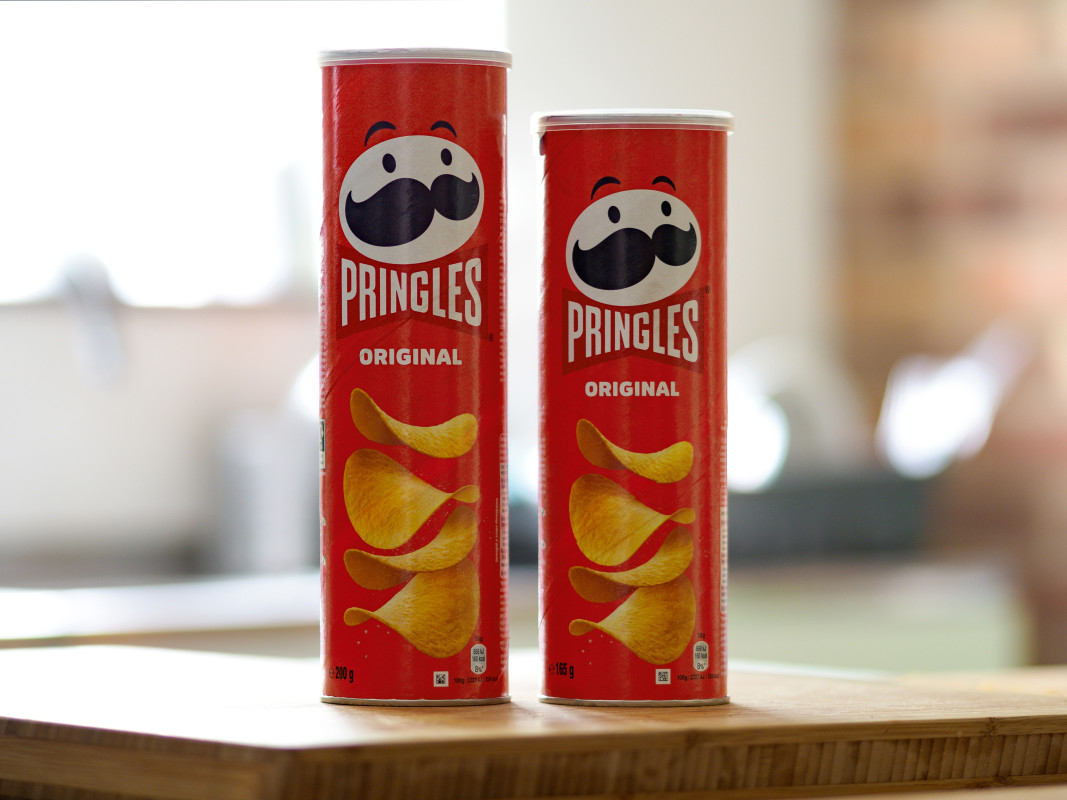
As most consumers know all too well, inflation refers to the prices of goods and services rising over time, eroding the practical value of currency by decreasing its purchasing power. Deflation, on the other hand, refers to falling prices — a far rarer phenomenon.
So what, then, is shrinkflation, the suddenly ubiquitous buzzword dominating economic headlines?
What does “shrinkflation” mean? The viral economic term explained
Shrinkflation refers to a reduction in the size of a consumer good (like a candy bar or bottle of dish soap) over time while the product’s price remains the same.
For example, a company that sells a 32-oz container of clothing detergent for $13.99 might reduce the container’s size to 28 oz but continue charging $13.99 rather than upping the price of the detergent. By doing so, the company effectively increases the price of its product by volume but avoids alarming customers with a sudden increase in the price of its product by container.
In one sense, shrinkflation can be seen as a somewhat deceptive tactic used by companies to conceal raising prices by reducing the amount of consumable product in each item sold rather than raising the item’s price. In another sense, however, it can be thought of as run-of-the-mill inflation, but expressed by falling product sizes instead of rising prices.
In either case, the result is the same: Consumers pay more over time, on a per-ounce basis, for the products they buy.
Is shrinkflation real? How prevalent is it?
The concept of shrinkflation makes sense, and the phenomenon has certainly become a popular scapegoat in economic media — President Biden even took a swing at it in the Super Bowl-themed social media video above — but is it actually happening on a significant scale and affecting consumers? And if so, how much of total inflation does it account for?
For starters, shrinkflation is happening, and it’s nothing new — plenty of examples have been widely documented for years. The Wikipedia page on shrinkflation, for instance, includes a picture of two Toblerone chocolate bars, one from 2006 and one from 2016, demonstrating that the latter is about 10% smaller than its predecessor. More recent examples of the phenomenon are listed later in this article.
The real question is, just how prevalent is shrinkflation in commonly purchased goods? And what proportion of total inflation can be accounted for by shrinking product sizes?
The U.S. Bureau of Labor Statistics, the federal fact-finding agency responsible for measuring inflation via the Consumer Price Index, has investigated this question carefully.
The BLS doesn’t just track changing prices; it also monitors “product size changes so the effective price change experienced by consumers can be accurately reflected in the CPI.” In February 2023, the agency released a detailed “Beyond the Numbers” report about product downsizing and its effect on inflation.
In this report, Kari McNair, a BLS economist, wrote, “The impact of product downsizing at the all commodity and services level is minimal, with an average annual effect of 0.01 percent per year, so while consumers may notice shrinkflation at the grocery store, it has a very small impact [on] the overall inflation picture they face.” In other words, shrinkflation is happening, but it’s not as big of a deal as some pundits make it out to be.
The report did reveal that some product categories are more affected by shrinkflation than others. Between January 2019 and October 2023, the unit prices of household paper products like paper towels and toilet paper, snacks, candy, chewing gum, cleaning products, and coffee were the most significantly affected by changing product sizes. That being said, even in the category most affected by downsizing (household paper products), only 3.6% of the price increase was due to changing product sizes. For snacks, the next most affected category, the number was even lower at 2.6%.

Shrinkflation in the spotlight: Real-world examples
- In 2021, General Mills (GIS) quietly phased out its 19.3-oz family-sized cereal boxes, replacing them with 18.1-oz boxes (a 6.2% reduction), according to NPR’s “Planet Money” newsletter.
- In 2022, Gatorade, owned by Pepsico (PEP) , redesigned its bottles, reducing their size from 32 oz to 28 oz (a 12.5% reduction) in the process, according to an article in Quartz. A company rep claimed the redesign was instituted only to make the bottles “more aerodynamic, and it’s easier to grab.”
- In 2021, Walmart (WMT) changed the sheet count of its Great Value Paper Towels from 168 per roll to 120 (a startling 28.6% reduction), according to the Washington Post.
- In early 2021, Tillamook announced that it was reducing the size of its ice cream cartons from 56 oz to 48 oz (a 14.3% reduction). This instance was unique in that the company — technically, the Tillamook County Creamery Association — announced the change to customers proactively rather than instituting it quietly and attempting to disguise it with a packaging redesign, a common tactic used by shrinkflation perpetrators.
- Back in 2008, for instance, Skippy reduced the size of its peanut butter jars from 18 oz to 16.3 oz. From the shopper’s view, however, the jars look exactly the same, as the company added a vertical indent to the jar’s base rather than reducing its height or width. (Skippy has been around since 1932 and has been owned since 2013 by Hormel Foods (HRL) .)
Related: What Is Disposable Income? Definition & Importance in Personal Finance
Is shrinkflation legal? Is it ethical?
Shrinkflation is perfectly legal. So long as an item’s packaging is accurately labeled with the amount or weight of product it contains, the company isn’t being deceptive from a legal standpoint. The onus is on consumers to determine if the product they’re buying is fairly priced for its size.
That said, many consumers hold the opinion that shrinkflation is unethical, at least in some cases.
Take the Skippy peanut butter example. By adding a volume-reducing dimple on the bottom of the jar rather than changing its size in a visible way, the company was able to downsize its product without broadcasting the change to its customer base. After all, why would you check the labeled weight of a product you regularly buy if the price hasn’t gone up and it looks the same as it always has?
This struck many as purposely deceptive once the change began to stir media coverage.
Tillamook, on the other hand, was up-front about its 2021 downsizing and explained the choice to its customers directly, making the following statement in its newsletter: “From [our] research we learned that consumers’ top two ice cream priorities are brand and price … we decided the option that would be least disruptive to our fans was to reduce our carton size and maintain the unit price … to deliver you the same high-quality Tillamook Ice Cream you love at an approachable price.”
There is nothing inherently wrong with a company changing the price or size of its product offerings so long as these changes are made transparently. Most complaints about shrinkflation stem from consumers feeling deceived by product downsizing disguised as package redesign.
How to fight shrinkflation: Total price vs. unit price
Shrinkflation occurs at the whim of popular brands. So, the only real way for consumers to avoid or combat it is by being wary shoppers and avoiding products whose unit prices are higher than those of their competitors — or higher than they used to be.
Unit price refers to how much a product costs per unit of measure (e.g., per ounce or quart). Unit price information allows consumers to compare the costs of different brands of a certain type of product, even if the brands sell the product in different sizes of containers. Many grocery stores display products’ unit prices next to their sale prices.
So, instead of comparing the prices of two different jars of jam, for instance, shoppers can compare the per-ounce price of jam between brands, regardless of jar size and make their decisions accordingly.
Related: Buy now, pay later apps: Are Affirm, Afterpay, Klarna & more safe?
Can shrinkflation affect services or just products? Skimpflation & sh*tflation explained
In addition to referring to shrinking product sizes, shrinkflation encompasses other types of subtle inflation as well, some of which have earned monikers of their own.
“Skimpflation” is a term typically used to refer to a reduction in service quality. For instance, a supermarket might schedule fewer checkers than it used to, resulting in longer checkout wait times. Similarly, a ski resort might stop running free shuttles from its overflow parking lot to its base (or run them less often).
“Sh*tflation,” sometimes used interchangeably with skimpflation, typically refers to a reduction in the quality (rather than the size or amount) of a product. For example, a cereal bar company facing rising ingredient costs might switch from an organic grain provider to a cheaper, lower-quality grain source rather than raise its price. Similarly, a salad dressing company that once used olive oil in its blends might quietly switch to a cheaper oil like canola.







